Top 10 Warehouse Safety Tips
The National Safety Council estimates more than 4.6 million workplace injuries occur in the United States each year, and that up to 25% of all industrial accidents occur at the loading dock. Even more, it is estimated that for each reported accident, there are 600 near-misses. Thus, facility managers are increasingly looking for ways to proactively address potential safety issues in their warehouses, instead of merely reacting to accidents.
Here are the top 10 warehouse safety tips that you can implement to reduce risk and help ensure employee safety. We will cover how to improve warehouse safety and what Rite-Hite equipment is best for each situation.
1. Help Protect Against Vacant Drop-Off
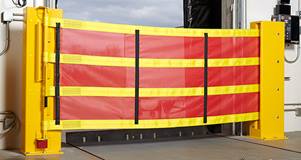 Summertime means more possibilities of open doors at the loading dock. That is why it is so imperative that you review your loading dock safety procedures. Are they working, and if not what do you plan to do to correct it? Help keep your personnel safe around open dock doors by improving dock door safety. A fall from an open, unprotected dock edge (typically a 4-foot drop) can result in serious injury or even death for forklift operators. If you'd like to learn more about fall protection and forklift safety, check out our newsletter on Fall Protection & Forklift Safety: OSHA's Top List of Workplace Safety Violations.
Summertime means more possibilities of open doors at the loading dock. That is why it is so imperative that you review your loading dock safety procedures. Are they working, and if not what do you plan to do to correct it? Help keep your personnel safe around open dock doors by improving dock door safety. A fall from an open, unprotected dock edge (typically a 4-foot drop) can result in serious injury or even death for forklift operators. If you'd like to learn more about fall protection and forklift safety, check out our newsletter on Fall Protection & Forklift Safety: OSHA's Top List of Workplace Safety Violations.
To comply with OSHA’s Walking Working Surfaces regulations, look for barriers that are at least 42 inches tall with a 200lb downward deflection of no less than 39". The Dok-Guardian® XL is an excellent solution that does just that. If you want to take your warehouse safety a step further, choose a leveler with a Safe-T-Lip® barrier.
2. Help Prevent Trailer Separation Accidents with Vehicle Restraints
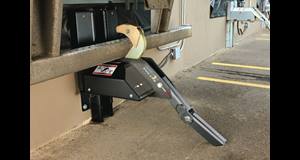
There are four kinds of traditional trailer separation accidents that can happen during loading at the dock – trailer creep, trailer pop-up/up-ending, landing gear collapse, and early departure. Any of these accidents can damage product and material handling equipment as well as seriously injure forklift operators inside and outside of the trailer. The most effective way to address these risks and help improve warehouse safety is choosing a proper vehicle restraint for each dock position's application. Always paired with active restraint status communication, Dok-Loks® help to ensure that the trailer is safely secured during loading.
3. Program-In Safety Operating Procedures
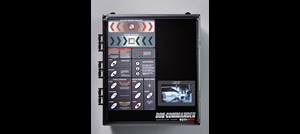
Traditionally, each piece of loading dock equipment – including vehicle restraints, loading dock levelers and overhead dock doors – is operated independently. While most are now operated with the push of a button, there is still risk involved regarding the order of use.
The Dok-Commander® control system helps ensure that workers operate equipment in a safe sequence of operation. For example, a common programmable sequence requires the vehicle restraint to be properly engaged before an overhead door can be raised. Continuing this safe dock door safety sequence, the door must then be raised before the dock leveler can be operated. Even if the buttons are erroneously pushed out of order, the programmed sequence prevents anything from happening – helping to mitigate the potential for risk from human error.
4. Help Prevent Back-Over Accidents on the Drive Approach
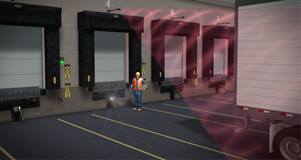
Surrounded by ambient noise on the drive approach, workers on the drive approach may not hear the sounds of a semi-trailer backing toward them as the truck’s engine could be up to 70 feet away. Backing hazards can lead to back-over accidents, and sometimes fatalities. In face, OSHA reports that semis are the second leading cause of backover fatalities in the United States. Thankfully, Rite-Hite offers various pedestrian safety solutions to help address these hazards as well as reduce processes that place workers out on the dangerous drive approach:
• Approach-Vu™ - utilizes a light and horn system to proactively present a clear visual and audible warning to pedestrians in the drive approach, communicating the need to vacate due to a backing threat.
• Lok-Vu™ - uses an outside single or dual camera paired with an inside monitor to help keep boots off the ground and maintain supply chain integrity. The camera helps workers inside to see when a trailer has arrived at a given dock position, if the trailer is properly restrained and if dual camera application - verify trailer stand presence.
5. Use Warning Sensors for the Dock Interior and at Blind Intersections
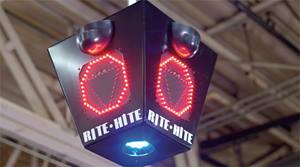
The interior of a loading dock opening can also be a dangerous place, as pedestrians may not see forklifts backing out of the trailer in time. Rite-Hite has developed blue light technology solutions that address this:
• Pedestrian-Vu™ - When activity is detected inside the trailer bed, Pedestrian-Vu emits a blue light (similar to the blue safety lights on forklifts) onto the dock leveler, extending reaction time by warning nearby dock workers and material handlers of the potential danger.
• Safe-T-Signal® - can communicate when pedestrians or fork truck traffic are approaching an intersection by employing high-visibility LED lights, including a blue LED light onto the floor.
• Safe-T-Vu™ – a rack-mounted device that uses a flashing red LED light to alert workers when traffic is approaching from another direction to help prevent accidents at aisle ends and other high-risk intersections.
6. Keep Your Docks Dry and Free of Debris to Prevent Trips, Slips and Falls
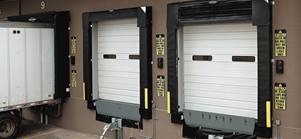
Trips, slips and falls are regularly reported as one of OSHA’s top 10 most common industrial accidents. One way to prevent them is to prevent moisture from accumulating inside your loading dock. Unfortunately, many docks aren’t sealed as well as they could be, and even small openings around the perimeter of a docked trailer could let in a dangerous amount of rain, snow or sleet. If you can see daylight through a perimeter gap, it’s time to consider upgrading your seals and/or shelters. Consider foam compression style dock seals such as the Performer™ or Classic™ dock seal, or a perimeter sealing dock shelter such as the Eclipse®. Selecting the right seal or shelter for your specific application will help guarantee sealing efficiency and employee safety.
7. Protect Against Falls from Elevated Spaces by Utilizing Dual Reciprocating Barriers
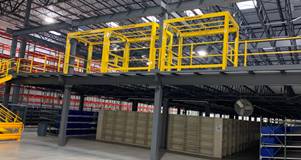
Fall safety related to elevated workspaces is a huge concern for plant managers. According to the ANSI standard, companies must provide full-time protection when loading and unloading materials from an elevated platform – there can be no exposed areas where an employee could potentially fall. Dual reciprocating barriers, such as the GateKeeper®, are a great choice for this application, since they create a controlled access area in which the inner gate and outer gate cannot be opened at the same time.
8. Reduce Collisions Between Forklifts and Workers with "See Through" High-Speed Doors with LED Lights
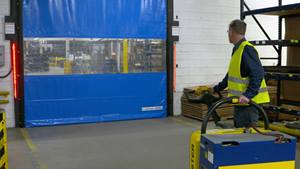
Working near high-speed doors can be dangerous, as forklifts may not come to a full stop before going through. Knowing when an object is about to pass through a door opening can prevent a host of potential accidents, including collisions between forklifts and workers.
LED Virtual Vision has been developed to address this problem. When the sensors detect an object approaching, a strip of red light emitting diodes (LEDs) begin flashing on the opposite side alerting workers of potential danger. Such systems can be an alternative or complement to high-speed doors with clear plastic vision panels. Although the LED lights are typically placed just outside of the door’s frame on each side, they can be set up anywhere that enables the best visibility.
9. Prevent Trailer Up-Ending with Trailer Stabilizers or Trailer Stands
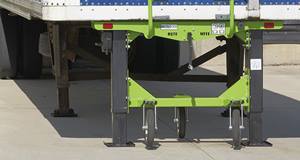
Place trailer stabilizers or trailer stands under the nose of spotted trailers to help prevent trailer up-ending or other accidents due to landing gear collapse. Products such as the TS-5000 Trailer Stabilizer acts as back up to existing landing gear support. Seldom used or rusted landing gear may collapse under extreme weight conditions. When the trailer stabilizer is positioned snug under a spotted semi-trailer at the loading dock, it will support a static load capacity up to 140,000 lbs.! The extra wide top plate (66”) and twin vertical supports will help absorb momentum caused from landing gear collapse and help minimize the trailer nose from dropping or tipping.
10. Use Data to Diminish Risk
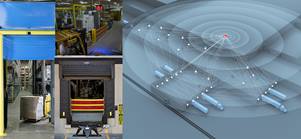
For decades, logistics operations have relied on two-way radios, yard checks on foot and spreadsheets to manage the flow of trailers in and out of their facility. These traditional communication methods provide somewhat limited and outdated information, but until recently they were the best available.
Our dock management and communication software brings an enhanced sense of clarity and order to logistics operations from the dock interior, to the drive approach and even the yard – helping to minimize detention and demurrage costs. These enhancements are likely to have a positive impact on shipper of choice status and internal company culture.
When connected to a smart warehouse solutions platform, data from Rite-Hite equipment at loading docks, blind intersections and interior door openings can be used for operational improvements, data-driven decisions, and more. Rite-Hite’s smart data and analytics can distill this information to provide managers with actionable insights about safety, energy efficiency and productivity for both the short - and long term.
Find a Rep Contact Us